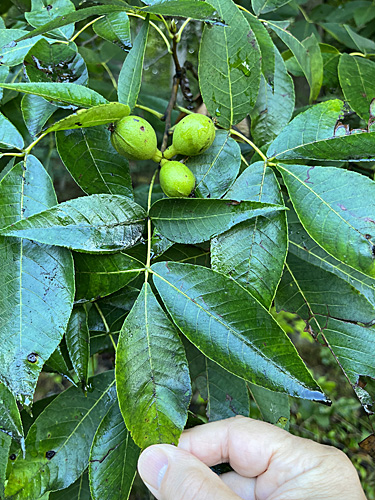Volume 28 Issue 3, Summer 2023
by Jennifer Lumley, Audubon at Home Ambassador
I walked past a Mockernut Hickory (Carya tomentosa) tree after the ripe nuts had fallen to the ground and had the idea to bring some home, shell them, and add their meats to a batch of shortbread. Writing that in a sentence was easier than carrying it out as a task, a process that required smashing each hard, thick inner husk with a hammer, then using a metal pick to pry out tiny nut crumbs. The shortbread was the most fragrant and flavorful I’ve ever had, but even if I were to purchase a hickory nut cracker (it is telling that specialty tools are made for this), I wouldn’t repeat the experiment. I would try the reportedly thinner-husked Shagbark Hickory (Carya ovata) nuts.

The compound leaf of a native Pignut Hickory, showing its typical five leaflets plus three teardrop-shaped immature nuts. Photo by Jennifer Lumley.
Shagbark Hickory is present in Loudoun but not native here, while Mockernut, Pignut (Carya glabra), and Bitternut Hickories (Carya cordiformis) are. All four species have feather-compound leaves with toothed edges that occur in an alternate pattern along the twig. Bitternut Hickory nuts are true to their name and unsuitable for shortbread, and though hogs like the hickory named in their honor — Pignut — they are not generally considered to be delicious for humans.
We can split these trees into two groups based on the number of leaflets along the stem. The Mockernut and Bitternut usually have seven to nine leaflets, while the Shagbark and Pignut usually have five. To distinguish the Mockernut from the Bitternut, look for wooliness on the stem and leaf back, then check for an orange tint on the leaf, and a noticeable odor (often described as spicy) when the leaf is crushed. These traits are more reliable than comparisons of leaf size and shape, which can vary a lot depending on the age of the tree or height of the leaf within the tree canopy. When the trees are in fruit, telling the two apart is easy. Look for a thick brown shell that splits almost to the base when ripe in the case of the Mockernut, and a yellow-green nut with raised seams for the Bitternut.
The Shagbark and Pignut are also easy to tell from one another based on the ripe nuts. The Pignut has a smooth brown shell in the shape of a teardrop, while the Shagbark nut looks more like a squat, brown, four-part pumpkin. Identifying these last two trees based on their leaves is difficult, so look instead at bark and habitat. The mature Shagbark has bark that is in fact shaggy. It peels away from the trunk in long strips. It also generally prefers rich damp soil along streams, while the Pignut — like the Mockernut — is found more often on ridges and in somewhat dry soil. The Bitternut shares the Shagbark’s preference for moister habitat.
Hickories are large, slow-growing, long-lived trees whose leaves turn shades of warm bronze and rich, golden yellow in fall. They are larval hosts for the beautiful Luna, Funeral Dagger, and Giant Regal moths. And the edible nuts are incomparable in shortbread.

